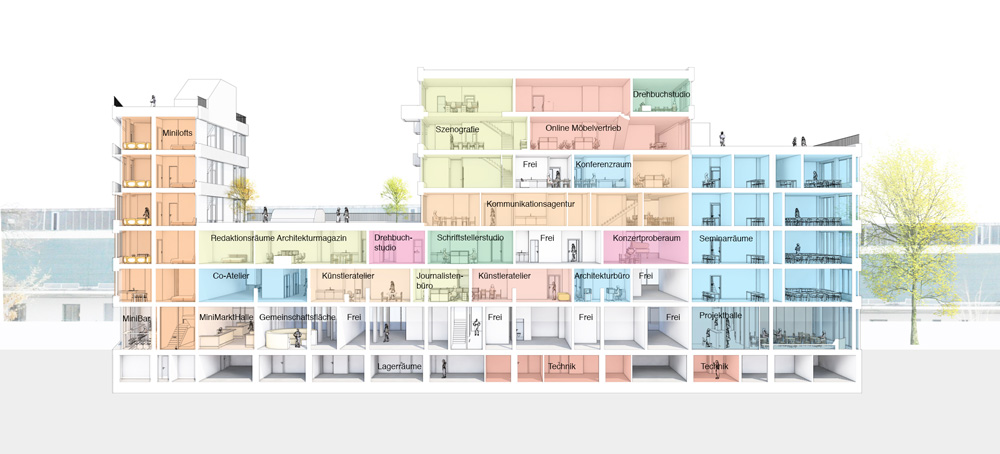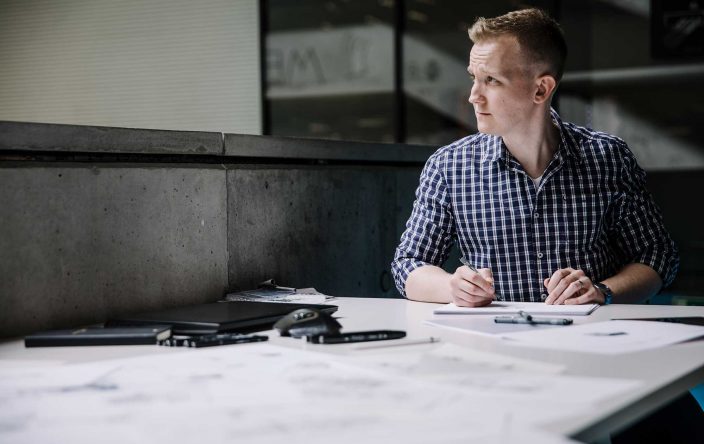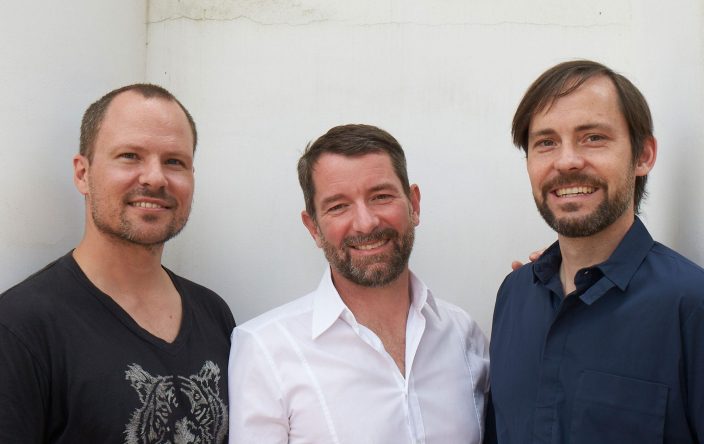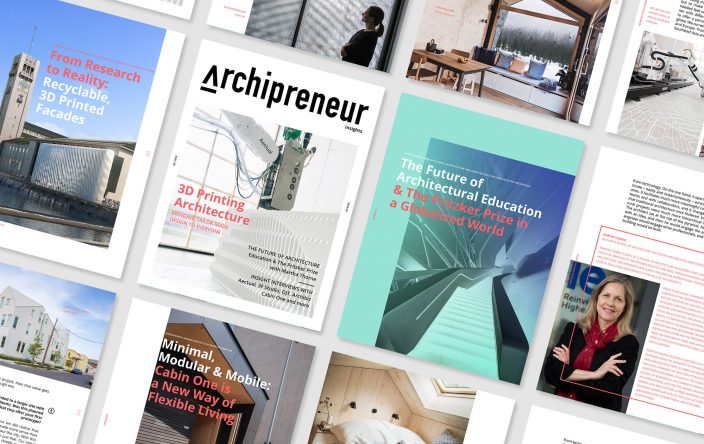
How to Create Unique Urban Projects as an Architect Developer with Matthew Griffin
Welcome back to “Archipreneur Insights”, the interview series with leaders who are responsible for some of the world’s most exciting and creatively disarming architecture. The series largely follows those who have an architectural degree but have since followed an entrepreneurial or alternative career path but also interviews other key players in the building and development community who have interesting angles on the current state of play in their own field.
This week’s interview is with Matthew Griffin, co-founder of Deadline, a Berlin based office for architectural services founded together with Britta Jürgens in 1993.
Since it first launched, Deadline has experienced an evolution in Berlin from abundant empty space in the center of town with no investors, to a shortage of space and investors knocking at their door – or as they put it “from ‘Wild East Frontier’ to ‘Hipness Capital of Europe’.”
I met Matthew in his office on the top floor of Deadline’s first building Slender/Bender, that we recently introduced to you in our projects series.
Bender is a stainless steel modernistic building that was built on a narrow lot. It connects to the renovated building known as Slender. These buildings comprise short-term apartments, office space, a shop, car parking and an award winning, two-storey family “house” with a roof garden. Deadline realized this project as architect developers with control over all the aspects of the building process. And they stuck with this practice.
Deadline is currently working on Germany’s first cultural co-ownership project, FRIZZ23, in Berlin Kreuzberg. In doing so, Deadline’s founders are expanding Berlin’s tradition of co-housing projects to a larger scale of collaborative thinking and collaborative developing.
Keep reading, to learn about Matthew’s motivation to take on the role of being a developer in addition to that of an architect, and to hear about the potentials and opportunities that have come from this move.
I hope you enjoy the interview!
What made you decide to found Deadline? Was there a particular moment that sealed the decision for you?
I’ve always been an entrepreneur. I started my first business when I was 14, repairing bicycles in my parents’ basement. It just seemed easier to start a business than to find a job.
And when I was in Berlin for the second time, it was 1993 and I was looking for a job, and there were lots of offices that would have hired me but they just didn’t have any office space. So then I thought, “Okay, well, why don’t we just do it from home and work for different offices, helping them on last minute projects.”
That’s where the name came from, Deadline – professionelle Hilfe in letzter Minute [last minute professional help]. The idea was that we would have a crew of people that would go around and help people out with tight deadlines. It never really worked that way, but it was a start.
Did you and Britta start working together as Deadline?
Britta had a job in an office at the time. We were working together, but she still had a full-time job. That was why it was possible for us to get going, because we had some income.
Then it just sort of morphed, and the work we got was doing measure drawings of buildings that were going to be renovated. This was in the middle of a big building boom with tax credits for renovating old buildings. Many archives had been destroyed in the war, so there were lots of buildings that needed plans drawn up. We would measure buildings, and whole housing settlements with 50,000 square meters and 30 people working for us over 2 shifts, it was really kind of crazy for a while.
You moved to Berlin in 1992. So you must have experienced a lot of development in the city. What major problems and opportunities do architects and developers in Berlin face today?
I think there’s been a complete shift in the problems and opportunities in the last decade. If you go back 10 years, it was reasonably easy to find interesting sites but it was really hard to find clients. And so, we had a situation where a lot of our friends and colleagues were starting to build cooperatives and find sites, buying them and becoming their own developers, because no one else was going to hire them.
Maybe you have to go back more than 10 years, maybe 15, but there was a time when a generation of architects didn’t have a chance. There was no building going on, and so the only way to start a practice would be to set up your own by developing a project. So the opportunity at that time was okay; there were all these great sites, but you had to be a good salesman and convince people that they should get on board.
Now there are people knocking on our door all the time, wanting to be a part of our projects, but it’s impossible to find a good site to develop. So, there’s been this shift. Right now we’re working on our FRIZZ23 project, so we’ve got enough work to keep us going for a while, but if we look into the future it’s hard to know where the new opportunities are going to be coming from. I expect that there’s going to be a shift in concentration; that we are going to be moving with our projects a little further off the Berlin center, and stuff like that.
For your project Minilofts, you bought a property, developed and expanded it, and now you manage it as a family-run apartment hotel. Could you elaborate on your motivation to shift from architect to developer and manager? What are the challenges; what are the opportunities?
We believe that to have the chance to do groundbreaking architectural work, you have to have control of many of the aspects that traditionally lie with developers. As money becomes more and more powerful, architects have less and less space to experiment, in particular because there’s very little public building going on now compared to 30 or 40 years ago. That might be part of the change, but the willingness of governments and administrations to experiment in architecture has decreased dramatically in my lifetime.
The interesting parts were when I was too young to be an architect. To practice now, if you want to experiment it really helps if you’ve got everything in your hand. That’s why we thought, “Okay, no one is ever going to trust us as young architects with almost no experience in building,” and we wanted to do something different, so that’s what led to us becoming our own clients.

Do you still build for clients or do you only develop your own projects like the Minilofts?
We don’t build a lot. For the project we are building right now, we have about 30 different clients. It’s a community-organized project, and we are also partially clients. The Minilofts make up 15% of FRIZZ23.
With the Minilofts business you have generated passive income. Can you make a living from this?
We can just about get by with the income from the Minilofts, but the important point is that it allows us to take risks and experiment with our architectural practice. Without this we would not be able to do the kind of work we are doing. To get FRIZZ23 off the ground we had to work for two and a half years without pay.
With your project FRIZZ23 you expand on Berlin’s Baugruppen tradition. Could you tell us a little about your approach of collaborative developing?
One of the really interesting things about FRIZZ23 is that it came out of Berlin’s first Liegenschaftskonzeptverfahren, the first sale of public land based on a conceptual tender process. This was, again, a very experimental thing. It was invented on the fly by all the people involved. There were three sites sold within this framework. Together with the other two projects we formed the Projektgruppe ex Blumengroßmarkt (PxB). We’ve been collaborating with PxB for the last four years.
It’s been fascinating in terms of how we can develop a city quarter in an unconventional way.
Each PxB project is based on a different collaborative model. Each project has certain experimental aspects in terms of how to develop the city, the goals it is trying to reach, and what it means to create something that is integrated into the community.
For FRIZZ23 we have adapted the collaborative housing development models established in Berlin over the last couple of decades to create cultural/commercial space.
Our community is made up of artists, writers, communications specialists, architects, publishers, a bike shop, a non profit education company, and, of course, the Minilofts. It’s a really fascinating, programmatic mix; a very small-scale mix. The smallest units are 28 square meters, and the largest units are 150 square meters. It has really been a good process. It’s complicated and tiring, but I think it will end up being a really lively place.

When will that be… is there a date yet?
Yes, there is a date, the dates always get pushed further into the future, but now we are actually going to start breaking ground on the 1st of August, and will probably get it done by April 2018. That’s the current plan, and I think it’s realistic.
For fresh architecture graduates who know very little about real estate development, how would you break down the process of getting the first project off the ground?
The thing that you have to be aware of is that the parameters are always changing. So the models that we used to build this space in which we’re sitting right now worked very well 15 years ago but wouldn’t work now. Even the model that we are currently working with for FRIZZ23 would not work if we started now. We’ve been working on it for almost five years. If you wanted to start the same project now, you would have to use another model.
As a small innovative team you have to always try and find a new model that works with the parameters suitable for the time, especially when you’re just starting out because it’s really hard to get enough capital to do things.
A decade or two ago there was nobody interested in investing in Berlin, it was pretty easy to find property at a reasonable price to get going. Now it’s the opposite; the whole investment world is looking at the city and everybody is pouring in money. It’s kind of ridiculous but that’s just the way things are right now. Maybe this will turn into a bubble that bursts in the next few years; then there will be all sorts of new opportunities. So it’s just about trying to find the opportunities that are available.
We started the Miniloft business in 2002. At the time, nobody was renting out apartments as an alternative to hotels. Now there’s new legislation preventing people from doing that. If we had tried to start Miniloft 10 years later, it wouldn’t have worked because the competition would have been too strong. We came in at a time when Internet advertising was very young. Google had just copied their Adwords system from a different company called Overture, and we began marketing our building with their services at a time when it was really cheap – two to five cents per click.
Then, five years later, when the financial crisis began, it was like two Euros a click, and we had to find other ways of marketing. Right from the start we were able to market a very small, specialized thing to a global audience at very low cost, and we used these technological changes that were happening at the time to found a business that now flourishes. Now the technological underpinnings are different, but we have established ourselves enough that we can expand.
I think that’s the way a business is; when you start out, you have to find something innovative. The economic forces are so strong that you cannot compete in an established market without a new idea to get started. That’s one of the prime problems of starting an architecture office. From a business point of view, an architecture office is a catastrophe. It’s very difficult to maintain an architecture office that produces good work and still works, financially.
Do you have any advice for Archipreneurs who are interested in starting their own business?
Yeah, go for it. I think you just have to start small, and start with what you can do with your own hands and feet, and find a way to be innovative. I think the biggest trap that you can get into is borrowing a lot of money and then finding out that it doesn’t work. So it’s the same you might hear from any high tech entrepreneur: you have to do what you can, and try to do that as fast as you can. Although the timescales in architecture are different than in the tech industry, you just have to try it out.
How do you see the future of the architectural profession? In which areas (outside of traditional practice) can you see major opportunities for up and coming developers and architects?
I really see the whole idea of community development as the future for innovative architecture, at least for a little while. I think that the major financial systems are running up against the wall because they’re producing unnecessary buildings. We’ve got a situation where a lot of capital is flowing into housing as purely speculative investment. The cost of capital is so low that people are producing buildings that don’t really have ‘proper’ use besides a way to park money, rather than serve an existing need on a rental market.
If you were actually trying to rent out these very expensive apartments, nobody would be able to afford them because the cost of production exceeds the means of a normal citizen.
So we’ve got this huge pressure that’s coming from money, which doesn’t have a good place to go, producing very expensive building infrastructure, that does not suit local needs. This is going to run out of steam sometime. It’s like a pyramid scheme: it’s working right now but there’s going to be a point where it’s not going to work anymore. Locally integrated community development is based on the principle of, “I build what I need,” and, “I build it exactly for that purpose.”
So you get very innovative buildings that are integrated into the community and the local fabric, and I see this as a way forward, particularly in difficult economic situations where standard formulas don’t work. In Berlin, that’s what we’ve been used to, at least my generation. Now that’s changing. We’re getting into a speculatively-driven development situation. Theoretically we have a housing shortage, I’m not sure if that’s really true, but everybody is saying we have a housing shortage, I believe that we don’t.
The future for architectural innovation is to try and find ways of developing the city together with the people. This is a major theme of the current biennale in Venice, which was really nice to see; it’s a theme that’s becoming more and more prominent.
It’s something that I’ve been working on basically all of my professional career, and my partner as well, of course, and many of our friends and colleagues, and the question is how do you take this further? I think with the FRIZZ23 project and the Projektgruppe ex-Blumengroßmarkt (PxB), we have taken this idea to a totally new level, and there are other colleagues working in town who are also experimenting in similar scales, and I think that that is the future.
Locally built projects for local needs is the way things will go, and this is insulated against the bubble being generated by expensive investment properties, for which I think the end is coming soon.
I hope so. Okay, thank you very much.
You’re welcome.
About Matthew Griffin
Studied Architecture at McGill University in Montreal (Bsc Arch 1993) and at the Architectural Association in London (AA Dipl. 1996). Co-founder of Deadline, Urban Issue, and LocallyGrownCity.net with Britta Jürgens. Lives and Works in Berlin. Active in various citizens initiatives, including Bürgerinitiative Invalidenstrasse, Team11 and Initiative Stadt Neudenken.
Deadline’s work explores the structural changes taking place (technological, social and economic) at the end of the mechanical age, and their particular effects on architecture and urban planning. To realize their projects they assume multiple roles intertwining political activism, project development, and design.
Deadline strives to inspire and empower people to create their city themselves, and explores these themes in the blog locallygrowncity.net.
Join our Newsletter
Get our best content on Architecture, Creative Strategies and Business. Delivered each week for free.

JOIN THE
ARCHIPRENEUR ACADEMY
- 9 Stage Studio Growth Roadmap
- Library of In-Depth Courses
- Checklists and Workbooks
- Quick Tips and Tutorials
- A Supportive Online Community















